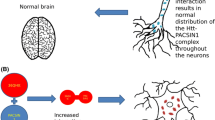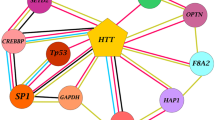Abstract
Huntington’s disorder (HD), caused by mutations of the IT-15 gene, is an autosomal genetic disease that causes the breakdown of the nerve cells in the brain. The IT-15 gene encodes the huntingtin (Htt) protein. Htt, along with its interacting partners, are involved in maintaining proper communication among neurons. Our work is based on the interaction behavior between Htt (in three polyglutamine (polyQ) states that is Htt 0Q, 17Q and 36Q) and SH3GL3 interacting protein by using computational methods. We used the HADDOCK docking platform to find out the extent of interaction between Htt polyQ models and SH3GL3. The Htt36Q (mutated) showed higher interaction than Htt17Q (native) with SH3GL3. Molecular dynamics simulation was performed to uncover the structural fluctuations of polyQ models and their complexes. RMSD, Rg, SASA, and total interaction energy graph showed significant results, where as mutant Htt showed higher fluctuations and flexibility than native Htt. The increase in the length of polyQ was found to affect the stability, flexibility, and compactness of the protein and its complex. Our research provided a propitious approach to understand the consequence of polyglutamination in Htt and its relation with HD.








Similar content being viewed by others
References
Zoghbi HY, Orr HT (2000) Glutamine repeats and neurodegeneration. Annu Rev Neurosci 23:217–247
Nakamura K et al (2001) SCA17, a novel autosomal dominant cerebellar ataxia caused by an expanded polyglutamine in TATAbinding protein. Hum Mol Genet 10:1441–1448
Vonsattel JP et al (1985) Neuropathological classification of Huntington’s disease. J Neuropathol Exp Neurol 44:559–577
Trottier Y, Devys D, Imbert G, Sandou F, An I, Lutz Y, Weber C, Agid Y, Hirsch EC, Mandel J-L (1995) Cellular localisation of the Huntington’s disease protein and discrimination of the normal and mutated forms. Nat Genet 10:104–110
DiFiglia M, Sapp E, Chase K, Schwarz C, Meloni A, Young C, Martin E, Vonstattel JP, Carraway R, Reeves SA et al (1995) Huntingtin is a cytoplasmic protein associated with vesicles in human and rat brain neurons. Neuron 14:1075–1081
Gutekunst CA, Levey AI, Heilman CJ, Whaley WL, Yi H, Nash NR, Rees HD, Madden JJ, Hersch SM (1995) Identification and localization of huntingtin in brain and human lymphoblastoid cell lines with anti-fusion protein antibodies. Proc Natl Acad Sci USA 92:8710–8714
Sharp AH, Loev SJ, Schilling G, Li SH, Li XJ, Bao J, Wagster MV, Kotzuk JA, Steiner JP, Lo A et al (1995) Widespread expression of Huntington’s disease gene (IT15) protein product. Neuron 14:1065–1074
De Rooij KE, Dorsman JC, Smoor MA, Den Dunnen JT, Van Ommen GJ (1996) Subcellular localization of the Huntington’s disease gene product in cell lines by immunofluorescence and biochemical subcellular fractionation Hum. Mol Genet 5:1093–1099
The Huntington’s Disease Collaborative Research Group (1993) A novel gene containing a trinucleotide repeat that is unstable on Huntington’s disease chromosomes. Cell 72:971–983
Sathasivam K, Amaechi I, Mangiarini L, Bates GP (1997) Identification of an HD patient with a (CAG)180 repeat expansion and the propagation of highly expanded CAG repeats in lambda phage. Human Genetics 99:692–695
Mangiarini L, Sathasivam K, Seller M, Cozens B, Harper A, Hetherington C, Lawton M, Trottier Y, Lehrach H, Davies SW et al (1996) Exon 1 of the Huntington’s disease gene containing a highly expanded CAG repeat is sufficient to cause a progressive neurological phenotype in transgenic mice. Cell 87:493–506
Scherzinger E, Lurz R, Trumaine M, Mangiarini L, Hollenbach B, Hasenbank R, Bates GP, Davies SW, Lehrach H, Wanker EE (1997) Huntingtin-encoded polygln expansions form amyloid-like protein aggregates in vitro and in vivo. Cell 90:549–558
Becher MW, Kotzuk JA, Sharp AH, Davies SW, Bates GP, Price DL, Ross CA (1997) Intranuclear neuronal inclusions in Huntington’s disease and dentatorubral and pallidoluysian atrophy: correlation between the density of inclusions and IT15 CAG triplet repeat length. Neurobiol Dis 4(6):1–11
DiFiglia M, Sapp E, Chase KO, Davies SW, Bates GP, Vonsattel JP, Aronin N (1997) Aggregation of Huntingtin in neuronal intranuclear inclusions and dystrophic neurites in brain. Science 277:1990–1993
Matilla A, Koshy BT, Cummings CJ, Isobe T, Orr HT, Zoghbi HY (1997) The cerebellar leucine-rich acidic nuclear protein interacts with ataxin-1. Nature 389:974–978
Skinner PJ, Koshy BT, Cummings CL, Klement IA, Helin K, Servadio A, Zoghbi HY, Orr HT (1997) Ataxin-1 with an expanded glutamine tract alters nuclear matrix-associated structures. Nature 389:971–974
Paulson HL, Perez MK, Tottier Y, Trojanowski JQ, Subramony SH, Das SS, Vig P, Mandel JL, Fischbeck KH, Pittman RN (1997) Intranuclear inclusions of expanded polygln protein in spinocerebellar ataxia type 3. Neuron 19:333–344
Igarashi S, Koide R, Shimohata T, Yamada M, Hayashi Y, Takano H, Date H, Oyake M, Sato T, Sato A et al (1998) Suppression of aggregate formation and apoptosis by transglutaminase inhibitors in cells expressing truncated DRPLA protein with an expanded polygln stretch. Nat Genet 18:111–117
Cattaneo E et al (2001) Loss of normal huntingtin function: newdevelopments in Huntington’s disease research. Trends Neurosci 24(3):182–188
Steffan JS et al (2000) The Huntington’s disease protein interactswith p53 and CREB-binding protein and represses transcription. Proc Natl Acad Sci USA 97:6763–6768
Dunah AW et al (2002) Sp1 and TAFII130 transcriptional activity disrupted in early Huntington’s disease. Science 296:2238–2243
Boutell JM et al (1999) Aberrant interactions of transcriptional repressor proteins with the Huntington’s disease gene product, huntingtin. Hum Mol Genet 8:1647–1655
Slepnev VI, De Camilli P (2000) Accessory factors in clathrindependent, synaptic vesicle endocytosis. Nat Rev Neurosci 1:161–172
Sun Y et al (2001) Polyglutamine-expanded huntingtin promotes sensitization of N-methyl-D-aspartate receptors via post-synaptic density 95. J Biol Chem 276:24713–24718
Giachino C, Lantelme E, Lanzetti L, Saccone S, Bella Valle G, Migone N (1997) A novel SH3-containing human gene family preferentially expressed in the central nervous system. Genomics 41(3):427–434
Schmidt A et al (1999) Endophilin i mediates synaptic vesicle formation by transfer of arachidonate to lysophosphatidic acid. Nature 401:133–141
Gao Y-G, Yan X-Z, Song A-X, Chang Y-G, Gao X-C, Jiang N, Zhang Q, Hu H-Y (2006) Structural insights into the specific binding of Huntingtin proline-rich region with the SH3 and WW domains. Structure 14(12):1755–1765
Nilges M (1995) Calculation of protein structures with ambiguous distance restraints. Automated assignment of ambiguous NOE crosspeaks and disulphide connectivities. J Mol Biol 245:645–660
Harjes P, Wanker EE (2003) The hunt for huntingtin function: interaction partners tell many different stories. Trends Biochem Sci 28(8):425–433
Pawson T (1995) Protein modules and signalling networks. Nature 373:573–580
Sittler A, Walter S, Wedemeyer N, Hasenbank R, Scherzinger E, Eickhoff H, Bates GP, Lehrach H, Wanker EE (1998) SH3GL3 associates with the huntingtin exon 1protein and promotes the formation of polygln-containing protein aggregates. Mol Cell 2:427–436
Purohit R, Sethumadhavan R (2009) Structural Basis for the resilience of darunavir (TMC114) resistance major flap mutations of HIV-1 protease. Interdiscip Sci 1(4):320–328
Purohit R, Rajendran V, Sethumadhavan R (2011) Studies on adaptability of binding residues and flap region of TMC-114 resistance HIV-1 protease mutants. J Biomol Struct Dyn 29(1):137–152
Rajendran V, Purohit R, Sethumadhavan R (2012) In silico investigation of molecular mechanism of laminopathy cause by a point mutation (R482 W) in lamin A/C protein. Amino Acids 43:603–615
Purohit R (2014) Role of ELA region in auto-activation of mutant KIT receptor: a molecular dynamics simulation insight. J Biomol Struct Dyn 32(7):1033–1046
Rajendran V, Sethumadhavan R (2014) Drug resistance mechanism of PncA in Mycobacterium tuberculosis. J Biomol Struct Dyn 32(2):209–221
Kamaraj B, Rajendran V, Sethumadhavan R, Kumar CV, Purohit R (2015) Mutational analysis of FUS gene and its structural and functional role in amyotrophic lateral sclerosis 6. J Biomol Struct Dyn 33(4):834–844
Tsigelny IF, Bar-On P, Sharikov Y, Crews L, Hashimoto M, Miller MA, Keller SH, Platoshyn O, Yuan JXJ, Masliah E (2007) Dynamics of α-synuclein aggregation and inhibition of pore-like oligomer development by β-synuclein. FEBS J 274:1862–1877. doi:10.1111/j.1742-4658.2007.05733
Bates G, Harper P, Jones L (2002) Huntington's Disease. Oxford University Press, New York
Zhang Yang (2008) I-TASSER server for protein 3D structure prediction. BMC Bioinform 9:40
Dominguez C, Boelens R, Bonvin AM (2003) HADDOCK: a protein–protein docking approach based on biochemical or biophysical information. J Am Chem Soc 125:1731–1737
Dominguez C, Boelens R, Bonvin AM (2003) The HADDOCK web server for data-driven biomolecular docking. Nat Protoc 5:883–897
Nilges M, Macias MJ, O’Donoghue SI, Oschkinat H (1997) Automated NOESY interpretation with ambiguous distance restraints: the refined NMR solution structure of the pleckstrin homology domain from beta-spectrin. J Mol Biol 269:408–422
Brunger AT, Adams PD, Clore GM, DeLano WL, Gros P, Grosse Kunstleve RW, Jiang JS, Kuszewski J, Nilges M, Pannu NS, Read RJ, Rice LM, Simonson T, Warren GL (1998) Crystallography and NMR system: a new software suite for macromolecular structure determination. Acta Crystallogr D Biol Crystallogr 54:905–921
Case DA, Pearlman DA, Caldwell JW, Wang J, Ross WS, Simmerling CL, Darden TA, Mertz KM, Stanton RV, Cheng AL, Clements L, Manilal S, Love DR, Morris GE (2000) Direct interaction between emerin and lamin A. Biochem Biophys Res Commun 267:709–714
Lloyd DJ, Trembath RC, Shackleton S (2002) A novel interaction between lamin A and SREBP1: implications for partial lipodystrophy and other laminopathies. Hum Mol Genet 11:769–777
Sakaki M, Koike H, Takahashi N, Sasagawa N, Tomioka S, Arahata K, Ishiura S (2001) Interaction between emerin and nuclear lamins. J Biochem 129(2):321–327
Hess B, Kutzner C, Spoel D, Lindahl E (2008) GROMACS 4: algorithms for highly efficient, load-balanced, and scalable molecular simulation. J Chem Theory Comput 4:435–447
Gunsteren WFV, Billeter SR, Eising AA, Hunenberger PH, Kruger P, Mark AE, Scott WRP, Tironi TG (1996) Biomolecular simulation: the Gromos 96 manual and user guide. Hochschulverlag AG an der Zurich, Zurich
Berendsen HJC, Postma JPM, Gunsteren WFV, Hermans J (1981) Interaction models for water in relation to protein hydration. In: Pullman B (ed) Intermolecular forces. D Reidel Publishing Company, Dordrecht, pp 331–342
Berendsen HJC, Postma JPM, DiNola A, Hakk JR (1984) Molecular dynamics with coupling to an external bath. J Chem Phys 81:3684–3690
Essmann U, Perera L, Berkowitz ML, Darden T, Lee H, Pedersen LG (1995) A smooth particle mesh Ewald method. J Chem Phys 103:8577–8593
Humphrey W, Dalke A, Schulten K (1996) VMD: visual molecular dynamics. J Mol Graph 14:33–38
Emsley P, Cowtan K (2004) Coot: model-building tools for molecular graphics. Acta Crystallogr Sect D 60:2126–2132
Halperin I, Ma B, Wolfson H, Nussinov R (2002) Principles of docking: an overview of search algorithms and a guide to scoring functions. Proteins Struct Funct Genet 47:409–443
Janin J, Henrick K, Moult J, Eyck LT, Sternberg MJ, Vajda S, Vakser I, Wodak SJ (2003) CAPRI: a critical assessment of predicted interactions. Proteins Struct Funct Genet 52:2–9
van Dijk M, van Dijk ADJ, Hsu V, Boelens R, Bonvin Alexandre MJJ (2006) Information-driven protein–DNA docking using HADDOCK: it is a matter of flexibility. Nucleic Acids Res 34(11):3317–3325. doi:10.1093/nar/gkl412
Lobanov MY, Bogatyreva NS, Galzitskaya OV (2008) Radius of gyration as an indicator of protein structure compactness. Mol Biol 42(4):623–628
Elizabeth Durham, Brent Dorr, Nils Woetzel, Rene Staritzbichler, Jens Meiler (2009) Solvent accessible surface area approximations for rapid and accurate protein structure prediction. J Mol Model 15(9):1093–1108
Kim MW, Chelliah Y, Kim SW, Otwinowski Z, Bezprozvanny I (2009) Secondary structure of Huntingtin amino-terminal region. Structure 17(9):1205–1212
Acknowledgments
We gratefully acknowledge the Bioinformatics Resources and Applications Facility (BRAF), C-DAC, Pune for providing the facilities to carry out this work.
Conflict of interest
The authors declare that they have no competing interests.
Author information
Authors and Affiliations
Corresponding author
Additional information
The authors Chandrasekhar Gopalakrishnan and Namrata Kalsi should be regarded as joint first authors.
IHBT Communication Number 3880.
Rights and permissions
About this article
Cite this article
Gopalakrishnan, C., Kalsi, N., Jethi, S. et al. Computational investigation of molecular mechanism and neuropathological implications in Huntington disease. Mol Cell Biochem 409, 1–11 (2015). https://doi.org/10.1007/s11010-015-2462-7
Received:
Accepted:
Published:
Issue Date:
DOI: https://doi.org/10.1007/s11010-015-2462-7




